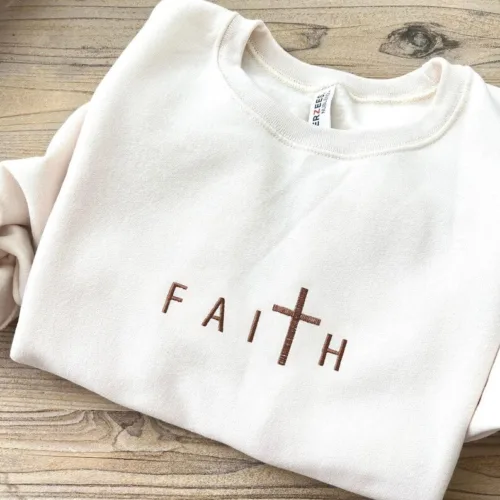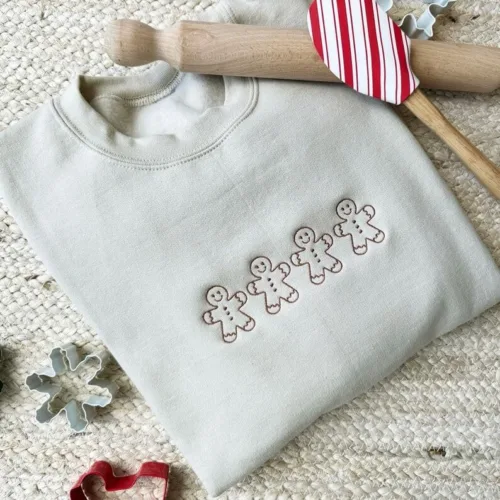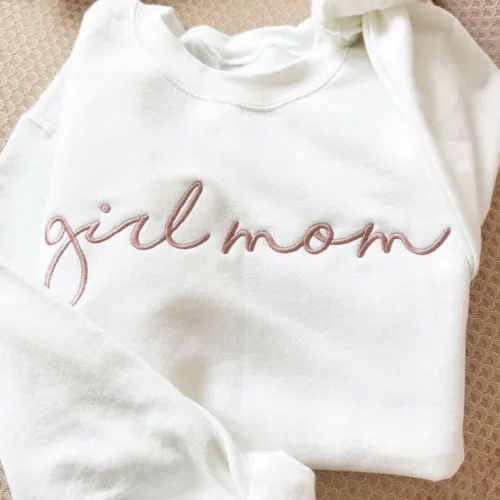The best discounts this week
Every week you can find the best discounts here.
Personalized Embroidered Hat, Custom Text, Custom Logo, Custom Your Image
Personalised Vintage Cap – Custom Embroidered Unisex Cotton Dad Hat with Personalized Text
Personalized Embroidered Cat Hat, Custom Dog Hat, Custom Hat Vintage Baseball
Custom Embroidered FAITH Crewneck Sweatshirt
Gingerbread Men Embroidered Sweatshirt
Girl Mom Personalized Crewneck Sweatshirt
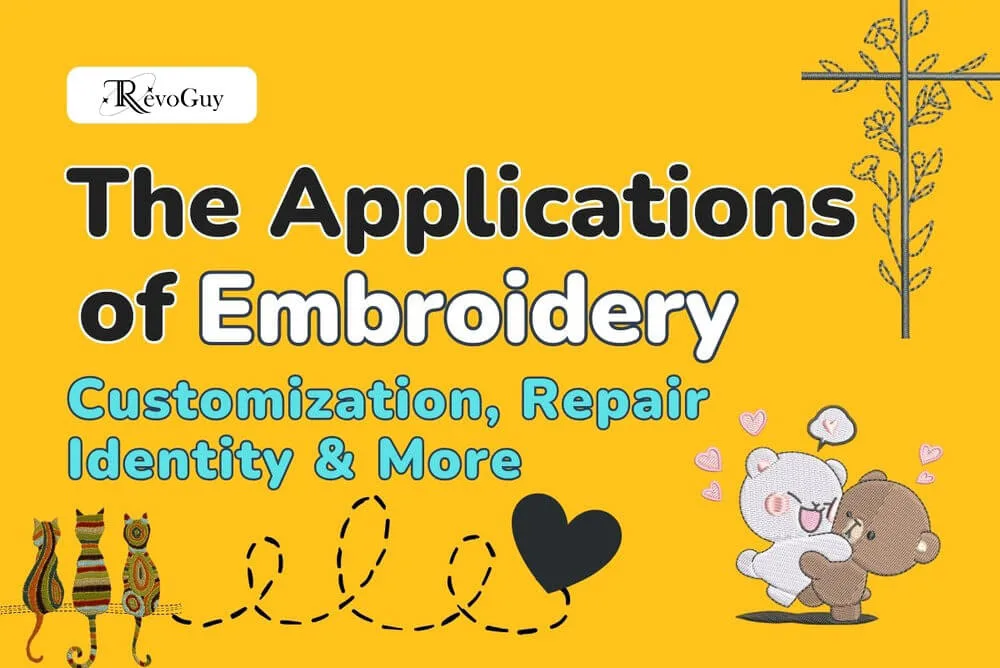
Table of Contents
Embroidery, an age-old art of decorating fabric with needle and thread, has remained a timeless craft. As with many traditional practices, it has adapted to modern needs, with new techniques and applications reflecting contemporary creativity. The versatility of embroidery stitches allows for endless possibilities, making it a perfect medium for both functional and artistic projects.
In this article, we will explore the diverse ways embroidery is used today, demonstrating how this classic craft continues to thrive in the modern world. From personalized fashion pieces to unique home décor, embroidery has found a new life, proving that its beauty and significance are as relevant now as ever before.
Transforming Apparel with Embroidery
Embroidery has emerged as a key element in fashion and apparel customization, offering a distinctive method to elevate the visual appeal of clothing.
Through embroidery, simple garments are transformed into one-of-a-kind creations. Whether it’s intricate patterns, vibrant images, or meaningful text, embroidery adds depth and character to clothing, creating visually striking designs. This customization offers a personal touch that many other design techniques simply can’t replicate.
Popular Embroidery Techniques and Their Uses
Embroidery’s versatility in apparel is evident across many different items:
T-shirts: Commonly adorned with logos, slogans, or decorative patterns.
Hoodies: Adds texture and enhances the overall style of casual wear.
Hats: Embroidered logos or small designs create a personalized touch on caps.
Jackets: From simple monograms to intricate back designs, embroidery brings a unique flair to outerwear.
Each embroidered garment tells its own story, offering individuals a chance to showcase personal style or brand identity.
Learning how to create your own embroidery designs can elevate your apparel decoration skills, opening up endless possibilities for customization and even the potential to start your own embroidery business.
The Role of Embroidery in Fashion Design
In the fashion industry, embroidery plays several important roles:
Creative Expression: Designers use embroidery to turn their unique ideas into reality, making garments stand out.
Heritage Preservation: Traditional embroidery patterns maintain cultural significance and keep historical techniques alive.
Craftsmanship Showcase: Intricate stitching highlights a designer’s skill and dedication to detail, adding an artisanal touch to fashion pieces.
Embroidery offers both functional and aesthetic benefits. It enhances durability while adding a tactile, textured quality to clothing. Whether for personal style, brand recognition, or artistic flair, embroidery remains a timeless and valuable technique in apparel customization.
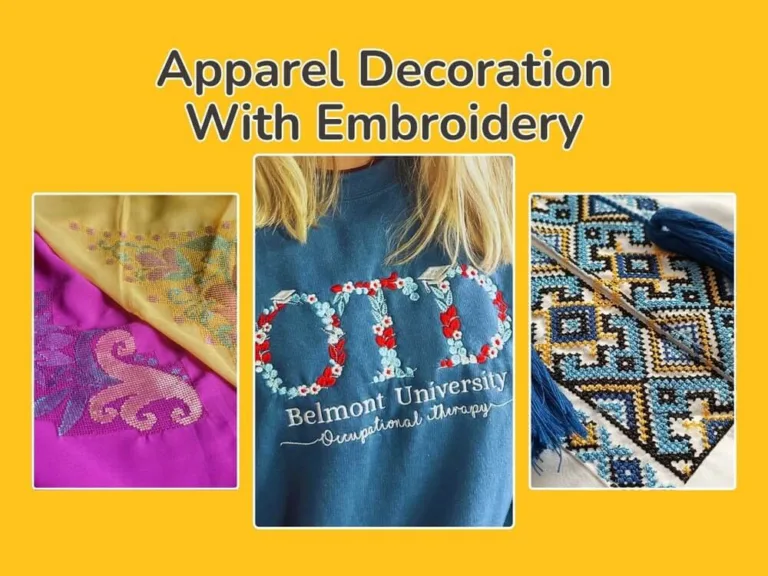
Brand Identity through Embroidered Logos
Embroidery plays a key role in shaping and reinforcing brand identity. The use of embroidered logos serves as an effective tool for visual communication and brand recognition.
With the advancement of computerized embroidery, logos embroidered onto uniforms, corporate wear, and promotional products bring a level of professionalism and sophistication. The raised texture and durability of machine embroidery lend a high-quality appearance that enhances the perception of a brand, making it more memorable to clients, customers, and the public.
Embroidered logos are commonly applied to a variety of items:
Corporate Uniforms: They provide a unified, professional look for employees.
Promotional Products: Embroidery adds value to giveaways and merchandise, making them more desirable.
Accessories: Items like bags and hats are transformed with embroidered logos, strengthening brand identity.
This versatility allows organizations to maintain a consistent brand presence across different products and services.
The widespread use of embroidered logos spans various industries, including:
Corporations: Both small businesses and large enterprises use embroidered logos to enhance their branding.
Sports Teams: Logos embroidered on jerseys, jackets, and fan merchandise reinforce team identity.
Event Organizers: Embroidered items make events memorable and help promote the event’s branding.
By incorporating embroidered logos into these sectors, companies and organizations create a lasting impact while ensuring that their brand is presented consistently and professionally.
Personalized Embroidered Gifts: Thoughtful and Unique
Embroidery has opened up a vibrant and imaginative world for gift-giving by creating unique, personalized items that hold special meaning for both the giver and the recipient.
The increasing demand for embroidered names, initials, dates, or custom designs on a variety of items has the ability to transform ordinary objects into cherished keepsakes. This customization adds sentimental value to many significant occasions in life.
Custom embroidery is particularly popular for:
Baby Clothing: Personalizing items with names and birth dates to celebrate a new arrival.
Graduation Memorabilia: Commemorating academic milestones with embroidered keepsakes.
Wedding and Anniversary Gifts: Marking special milestones with thoughtful, personalized designs.
Holiday Presents: Adding a personal and heartfelt touch to seasonal gifts.
The growing trend for personalized embroidered gifts presents a promising opportunity for entrepreneurs. With its popularity and wide application, embroidery is an attractive field for those interested in starting their own business. While making the leap from creating personalized gifts for loved ones to running a full embroidery business can feel overwhelming, the right guidance on How To Start Your Embroidery Business can turn a passion for embroidery into a successful venture.
The Growing Global Embroidery Market
The rise of personalized and custom embroidery has had a transformative impact on the gift market, offering consumers unique, individualized options that go beyond traditional gift-giving.
Many online retailers now provide customization services, making it easier for customers to design and order embroidered products. Websites like Thread Logic and Embroly have capitalized on this trend by allowing users to personalize gifts with names, logos, dates, and more.
In addition, small businesses have found a niche in creating bespoke embroidered items, offering even more tailored and creative products to customers. The demand for personalized embroidered gifts is growing, as it allows gift-givers to create something truly special and meaningful for recipients.
Online stores have made the customization process seamless by integrating embroidery options into their platforms, offering:
User-friendly interfaces for easy design creation
Preview features that let customers visualize their final product
Options for different fonts, colors, and embroidery placements
This accessibility has made personalized embroidery a popular choice for shoppers seeking one-of-a-kind gifts.
Global Embroidery Market Growth
The global embroidery market is experiencing impressive growth, driven by factors such as the expansion of the textile and apparel industry, advancements in technology, and the increasing consumer preference for customized products.
Market Size and Growth Rate:
The market was valued at approximately USD 2.98 billion in 2023 and is projected to reach USD 5.70 billion by 2030, reflecting a CAGR of 9.71% over this period. (Source: virtuemarketresearch.com)
Another report estimates the market size at USD 1.41 billion in 2023, growing to USD 2.19 billion by 2030, showing a CAGR of 6.4% from 2024 to 2030. (Source: valuates.com)
Key Applications of Embroidery
The key applications for embroidery include:
Apparel (the largest segment)
Household linens
Decorative fabrics
Embroidery has carved out a significant niche in the gift market by offering consumers the opportunity to create personalized, long-lasting items that reflect creativity and thoughtfulness. This growing trend allows people to give gifts that aren’t just objects but memorable pieces to be treasured for years to come.
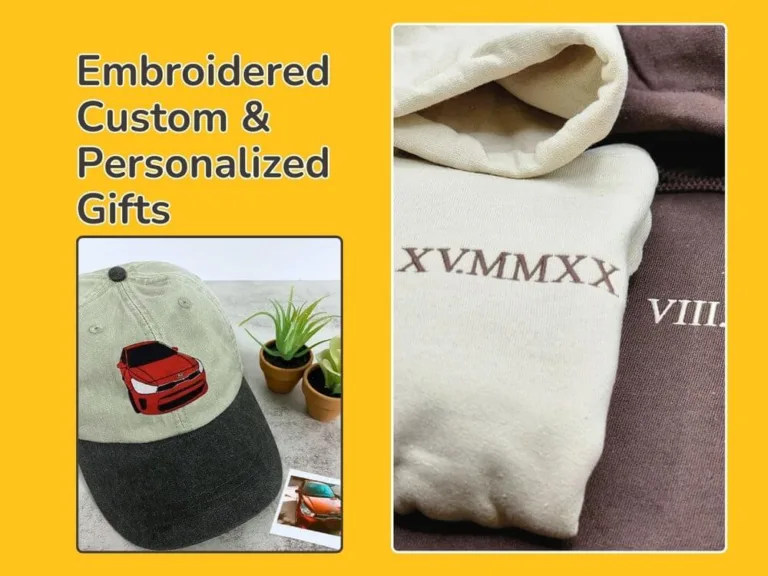
Home Decor: Elevating Elegance in Every Room
Embroidery has seamlessly integrated into home decor, bringing texture, color, and personality to various household items. This application of embroidery transforms everyday objects into beautiful, personalized pieces of art.
How Embroidery Enhances Home Textiles
Embroidery adds a touch of elegance and character to ordinary home textiles:
Pillows and cushions: Featuring intricate designs or bold, eye-catching statements.
Curtains: Incorporating patterns or borders to create a focal point in any room.
Tablecloths: Adding motifs and designs for a sophisticated touch, perfect for special occasions.
Some online retailers like Sweet Pea and Edy the Anne offer a variety of embroidered home decor options, allowing customers to add a unique, artistic flair to their living spaces. These embroidered elements often serve as focal points within a room, tying together color schemes or adding vibrant details to more neutral spaces.
Customization and Personalization in Home Decor
Embroidery provides endless possibilities for personalization, making home decor truly reflective of individual tastes:
Family monograms: Adding a personal, familial touch to linens and textiles.
Custom designs: Creating motifs that reflect specific interests, hobbies, or personal style.
Traditional patterns: Bringing cultural elements into modern homes, preserving heritage while enhancing interior decor.
This ability to customize allows homeowners to curate spaces that feel uniquely theirs, blending their personalities with their living environments.
Balancing Tradition and Modernity
Embroidered home decor successfully combines traditional craftsmanship with contemporary design elements:
Modern interpretations of classic patterns: Updated takes on timeless designs that suit modern sensibilities.
Mixing embroidery with other textile techniques: Combining embroidery with fabric printing, quilting, or weaving for a diverse look.
Unexpected color combinations: Using bold or unexpected color choices in traditional designs to create a fresh, modern feel.
This fusion of old and new ensures that embroidered home decor items can complement a broad range of interior styles, from cozy rustic spaces to sleek, modern aesthetics. Whether adding a touch of nostalgia or a contemporary twist, embroidery brings a unique and personal dimension to any home.
Embroidered Repair: Turning Damage into Design
Embroidery is now a go-to solution for repairing damaged clothing, transforming a once mundane task into an opportunity for creativity. Instead of simply patching up a hole, embroidery allows you to add a personal touch, turning the repair into an artistic statement. Whether it’s a subtle design or a bold pattern, embroidery enhances the garment and breathes new life into it, making the repair process not only functional but also visually appealing.
How to Fix Holes in Clothes Using Embroidery
The use of embroidery for clothing repair offers a creative and functional approach to mending. It not only fixes holes and tears but turns them into a decorative feature, giving garments new life and personality. This method helps extend the longevity of clothes while infusing them with unique, personalized flair.
Here’s how you can repair a hole with embroidery techniques:
Clean the area: Ensure the fabric around the hole is clean.
Trim loose threads: Cut off any ragged threads around the hole to tidy up the edges.
Back the fabric: Place a small piece of fabric behind the hole to provide extra strength.
Choose a design: Select an embroidery pattern that will seamlessly cover the hole.
Outline the hole: Start with a running stitch around the hole to create an outline.
Work from the outside in: Begin stitching from the outer edges toward the hole, gradually filling it in.
Create a patch effect: Use dense stitching to completely cover the hole, mimicking a patch.
Secure stitches: Tie off your stitches on the backside of the fabric to keep them in place.
Trim excess thread: Carefully trim any leftover thread and finalize the repair.
This method not only repairs the fabric but also gives your garments a unique, creative touch, making each item one-of-a-kind.
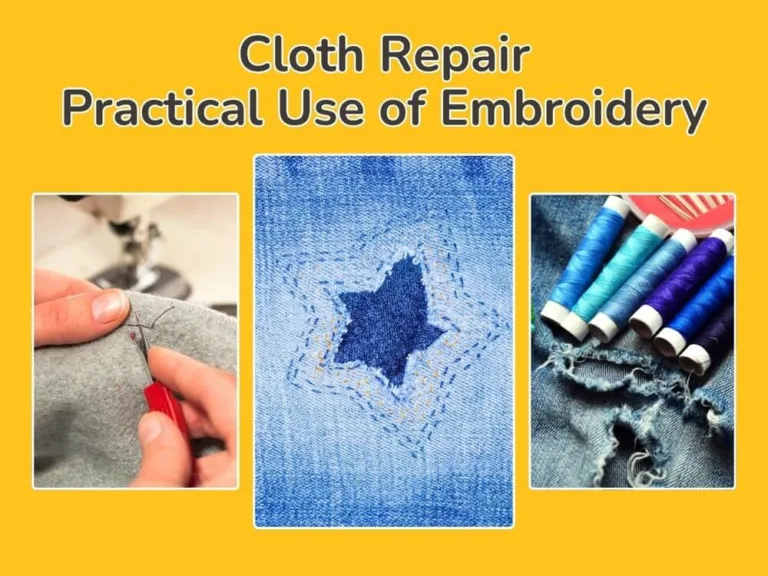
Transformative Mending Techniques: Fixing Clothes Creatively
Several embroidery techniques are commonly used for cloth repair, each offering a different approach to mending:
Visible mending: This technique deliberately highlights the repair, transforming it into a design element rather than hiding it. It turns imperfections into something beautiful and intentional.
Patchwork embroidery: Ideal for larger areas, this method covers damaged sections with decorative patterns, allowing you to blend repair with art.
Sashiko embroidery: A traditional Japanese technique, Sashiko combines simple, geometric stitching to reinforce fabric and create beautiful, intricate designs.
Using embroidery for repairs not only fixes damaged clothing but also promotes sustainability by encouraging the reuse and extension of garment life. It reflects a conscious effort to make fashion choices that are both creative and environmentally friendly.
The DIY Movement
The rise of DIY culture has contributed to the popularity of embroidered repairs. This movement includes:
Workshops: Teaching mending and embroidery techniques to empower individuals.
Online communities: Sharing ideas and inspiration for sustainable fashion practices.
Mending kits: Offering all-in-one solutions for at-home repair projects.
This shift encourages people to engage more deeply with their clothing, fostering a sense of accomplishment and a personal connection to the items they wear.
Embroidery in cloth repair is a blend of practicality and artistic expression, allowing individuals to solve a problem creatively while embracing sustainability. By transforming flaws into features, it revitalizes beloved garments and adds character.
Textile Art: Expressing Creativity Through Embroidery
Embroidery has moved beyond its traditional role in decoration to emerge as a respected form of fine art. Artists are now using needle and thread to craft detailed and impactful works that push the boundaries of textile art. This evolution highlights the versatility of embroidery as it embraces modern themes, blending skillful craftsmanship with powerful visual narratives.
Mastering Artistic Embroidery Techniques
In textile art, embroidery techniques offer a broad range of possibilities for creative expression:
Freeform stitching: Artists create organic shapes and textures, allowing the design to evolve naturally.
Layering: Multiple layers of thread build depth and dimension, transforming the artwork into a tactile experience.
Mixed media: Embroidery is combined with painting, printing, or other textile techniques, adding complexity and visual richness.
These innovative methods enable artists to stretch the limits of traditional embroidery, merging it with new mediums and ideas.
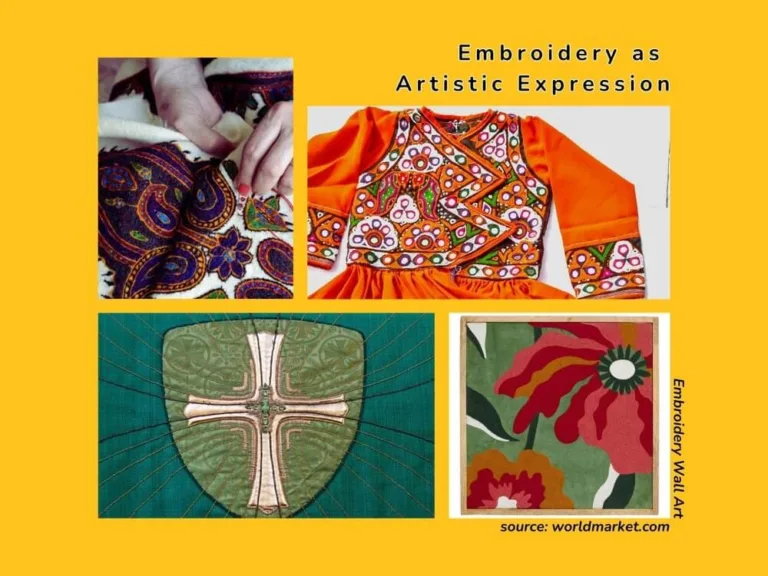
Threading Stories: The Art of Storytelling with Stitches
Embroidery art is increasingly being used as a powerful storytelling medium:
Cultural narratives: Embroidered pieces often depict historical events, folklore, or traditional stories, preserving cultural heritage.
Personal experiences: Artists use embroidery to express their memories, emotions, or significant moments, adding a deeply personal touch.
Social commentary: Embroidery art addresses contemporary social issues, using thread to communicate messages about the world today.
The tactile nature of embroidery imbues these narratives with a sense of intimacy, connecting the viewer with the story being told.
Exhibition and Recognition
Embroidery is gaining significant recognition in the fine art world:
Gallery exhibitions: Many galleries are now showcasing embroidered art as part of their curated exhibits.
Museum inclusion: Contemporary art museums are beginning to feature textile works in their collections, acknowledging their cultural significance.
Public art installations: Textile artists are being commissioned for large-scale public art projects, further elevating embroidery as a respected art form.
This growing recognition has created new opportunities for embroidery artists to reach wider audiences and showcase their work in esteemed settings.
Hand Embroidery in Traditional Craft and Culture
Embroidery holds a special place in many spiritual practices, bringing depth and reverence to religious garments and objects. Across different cultures and beliefs, it is used to embellish items with sacred symbols and meaningful patterns, adding both beauty and significance to rituals.
The Role of Embroidery in Religious Traditions
Sacred Vestments
Embroidery is a vital element in religious attire, enriching sacred garments across faiths:
Christianity: Chasubles and stoles adorned with intricate designs
Judaism: Tallitot (prayer shawls) and Torah covers with symbolic motifs
Islam: Prayer rugs and the Kiswah, the embroidered cloth of the Kaaba
Symbolic Motifs
Each tradition incorporates distinct embroidered imagery:
Christian symbols: Crosses, chalices, and scenes from scripture
Jewish motifs: Stars of David and beautifully rendered Hebrew calligraphy
Islamic designs: Elaborate geometric patterns and Arabic script
Ceremonial Objects
Embroidery enhances the beauty and sanctity of various religious items:
Altar cloths, processional banners, and ceremonial textiles
Intricately embroidered offerings used in Buddhist and Hindu temples
These embroidered elements help elevate the spiritual atmosphere, connecting tradition, artistry, and devotion.
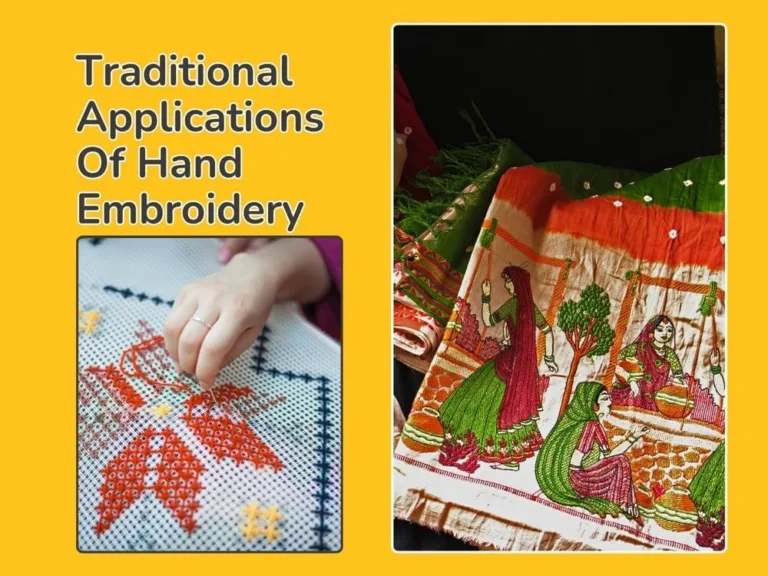
Embroidery as a Cultural Legacy
Traditional Costumes
Embroidery plays a key role in traditional dress around the world:
Eastern Europe: Folk dresses adorned with vivid floral patterns
Mexico: Huipils featuring intricate geometric designs
India: Saris embellished with luxurious zardozi embroidery
Storytelling and Heritage
Embroidery serves as a canvas for cultural memory:
Depictions of historical events and legends through stitched narratives
Tribal designs that signify ancestry and cultural belonging
Rites of Passage
Embroidered clothing marks life’s major milestones:
Wedding attire rich with symbolic motifs for blessings and unity
Special garments for coming-of-age or initiation ceremonies
Social Status Indicators
Intricate embroidery often signifies rank or origin:
Lavish designs worn by royalty and the elite
Regional or tribal patterns that reflect geographic roots
Ritual and Festive Attire
Festivals and ceremonies feature unique embroidered outfits:
Holiday garments specific to cultural or religious celebrations
Embroidered robes worn by shamans or community leaders
Across centuries, embroidery has been more than just ornamentation—it’s a powerful medium for honoring traditions, expressing beliefs, and reinforcing identity. Each stitch tells a story, linking the past to the present.
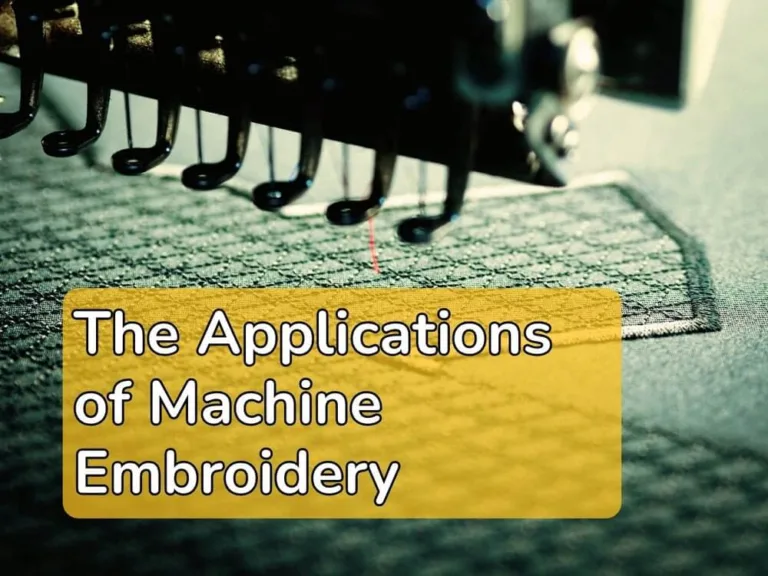
Creative Applications of Machine Embroidery
Machine embroidery has revolutionized the embroidery world, bringing speed, consistency, and detail to a craft once limited by handwork alone. By blending technology with creativity, this method has broadened embroidery’s role across industries—from fashion and home décor to branding and manufacturing.
Saving Time with Machine Embroidery
The speed of machine embroidery makes it ideal for:
Producing promotional items in large quantities
Manufacturing branded apparel on an industrial scale
Quickly delivering custom designs for individual or business needs
Its efficiency supports both mass production and personalized creations with ease.
Accurate Stitching Every Time
Machine embroidery offers several key advantages:
Precision and consistency: Produces high-quality results that are uniform across multiple items
Detailed execution: Handles intricate patterns with ease and clarity
Reduced errors: Automation minimizes the risk of mistakes in complex designs
These benefits make it a go-to choice for professionals and businesses alike.
Versatile Embroidery: Adapting to Any Project
Digital embroidery machines provide:
Extensive design libraries: Access to a wide range of pre-loaded patterns for quick use
Custom design flexibility: Easily create, edit, and scale personalized embroidery patterns
Versatile fabric compatibility: Suitable for embroidering on everything from cotton and denim to leather and synthetic materials
These features make digital machines ideal for both creative projects and commercial production.
Final Thoughts
Embroidery finds its place across multiple fields—fashion, home décor, religious objects, and corporate branding—blending age-old artistry with modern innovation. Its adaptability meets both creative desires and practical demands.
As trends evolve, embroidery continues to expand into areas like contemporary art, customization services, and eco-conscious fashion. Its power to personalize and convey meaning keeps it relevant in a fast-changing, digital-driven world.
More than just embellishment or repair, embroidery serves as a visual language of identity and expression. Whether crafted by hand or machine, it remains a vibrant and meaningful part of global textile culture.
FAQs About Applications of Embroidery
1. What are the most common uses of embroidery in the fashion industry?
Embroidery is widely used in fashion to personalize and enhance garments. Popular applications include stitching brand logos onto t-shirts, hats, and hoodies, adding monograms to bags and accessories, and incorporating intricate embroidery into high-end designer wear. These additions increase both the uniqueness and value of clothing items.
2. How has machine embroidery transformed the industry?
The rise of embroidery digitizing has revolutionized production by boosting speed, accuracy, and scalability. It enables the mass creation of detailed patterns, making high-quality customization more affordable and efficient. Machine embroidery has opened new creative possibilities while ensuring design consistency across products.
3. Is embroidery a practical method for clothing repair?
Definitely. Embroidery is an increasingly popular way to mend damaged garments. It can hide tears, strengthen worn areas, and convert flaws into artistic features. This visible mending technique blends repair with self-expression, making each fix a one-of-a-kind design element.
4. What are some sustainable uses of embroidery?
Embroidery contributes to sustainability by extending the life of clothing through decorative repairs and reinforcements. It can replace disposable printing methods with longer-lasting stitched designs and often uses eco-conscious materials like recycled threads or organic fibers. It’s also a key tool in upcycling, helping transform old items into fresh, wearable pieces.
5. How is embroidery applied in the business and corporate sectors?
Businesses use embroidery to strengthen their brand identity. Custom logos are embroidered onto uniforms, hats, and promotional merchandise to maintain a professional and consistent image. Embroidery stands out for its durability and premium look, which enhances the perceived quality of branded items.

Sophia Williams
Meet Sophia Williams, the 26-year-old wordsmith behind RevoGuy LLC's heartwarming content. This self-taught writer turned her passion for family stories into a career, weaving tales of love and laughter from her bustling Wyoming home office. With six years in the content creation world, Sophia has mastered the art of making Gen X and millennials alike misty-eyed over their morning coffee. When she's not crafting the perfect emotional hook, you'll find her attempting DIY projects or coaching little league. Her gift-giving advice is significantly more reliable than her home improvement skills.
Recent Posts
Recent Comments
Archives
Categories
Categories
- Accessories (3)
- Christmas's Day (13)
- Custom Product (55)
- Halloween (5)
- Women (36)
- Sweatshirts & Hoodies (62)
Hottest Deals
-
Sale Product on sale
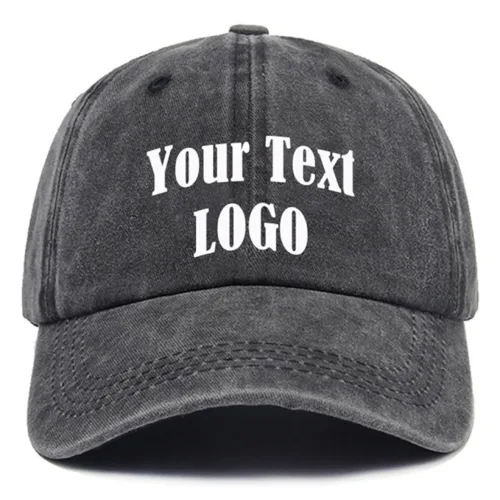 Personalized Embroidered Hat, Custom Text, Custom Logo, Custom Your Image
Personalized Embroidered Hat, Custom Text, Custom Logo, Custom Your Image$33.00Original price was: $33.00.$27.00Current price is: $27.00. -
Sale Product on sale
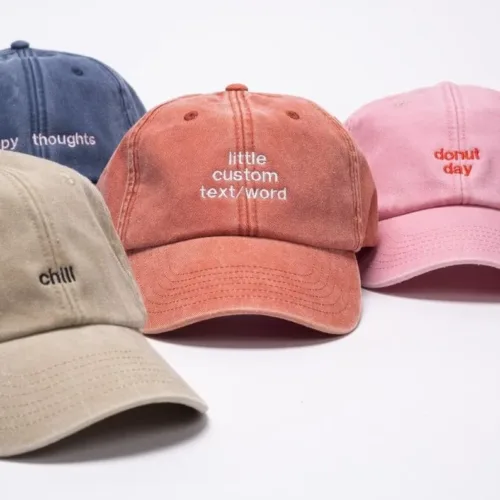 Personalised Vintage Cap - Custom Embroidered Unisex Cotton Dad Hat with Personalized Text
Personalised Vintage Cap - Custom Embroidered Unisex Cotton Dad Hat with Personalized Text$14.00Original price was: $14.00.$12.00Current price is: $12.00. -
Sale Product on sale
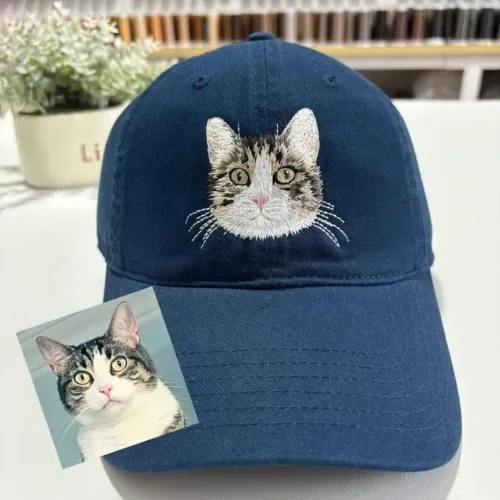 Personalized Embroidered Cat Hat, Custom Dog Hat, Custom Hat Vintage Baseball
Personalized Embroidered Cat Hat, Custom Dog Hat, Custom Hat Vintage Baseball$33.00Original price was: $33.00.$27.00Current price is: $27.00. -
Sale Product on sale
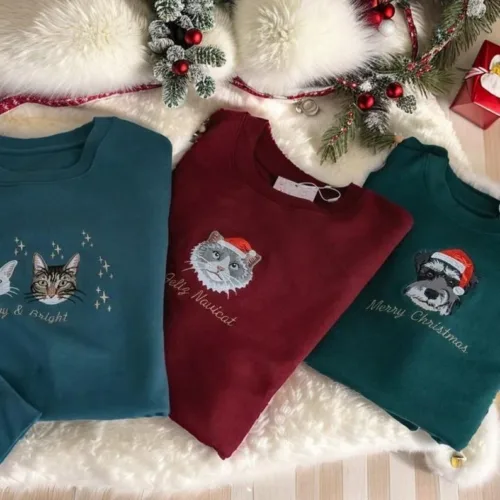 Christmas Edition Custom Pet Portrait Embroidered Sweatshirt$29.00 – $45.00
Christmas Edition Custom Pet Portrait Embroidered Sweatshirt$29.00 – $45.00

